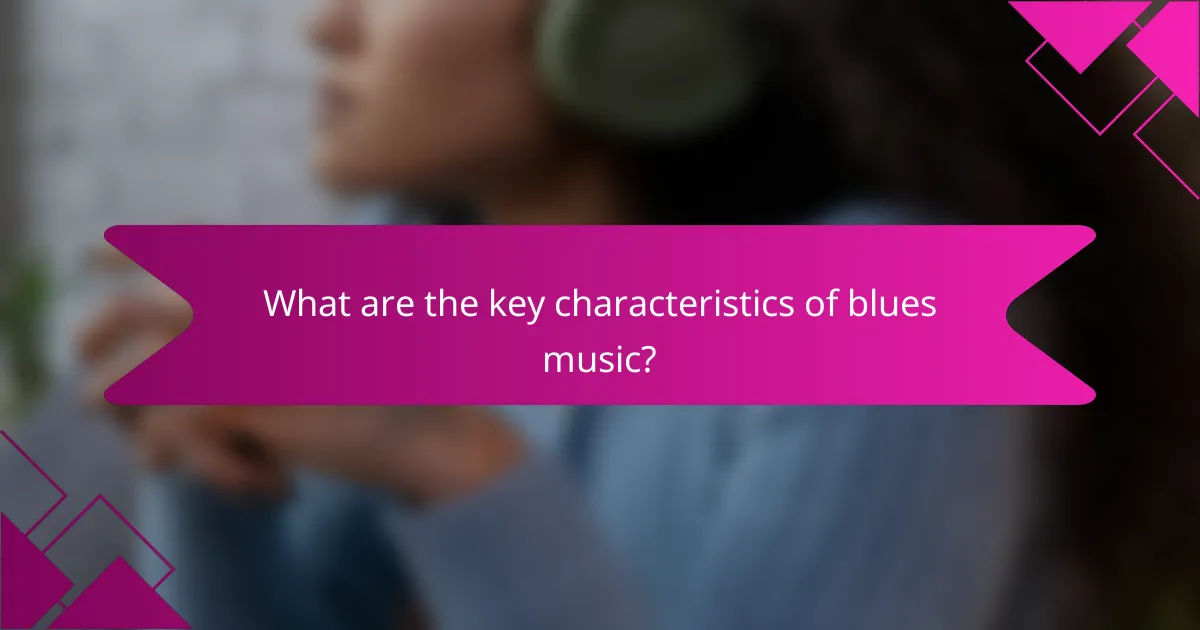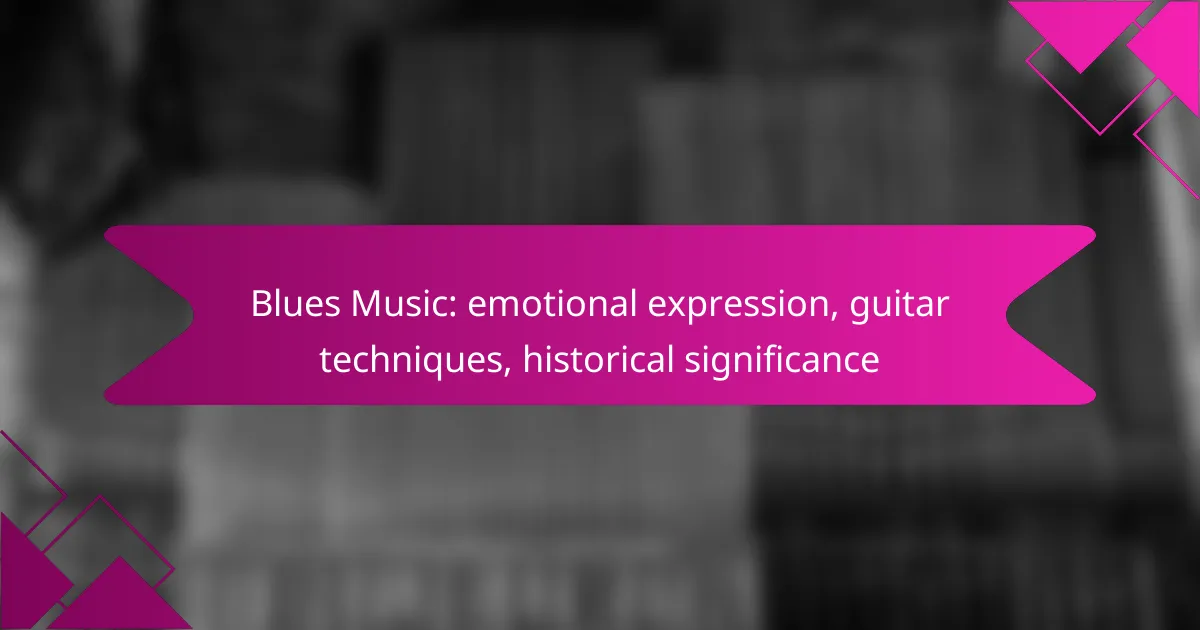Blues music is a profound form of emotional expression, characterized by its deep lyrical content and unique melodic structures that convey feelings of sorrow, longing, and resilience. Essential guitar techniques such as bending notes and slide guitar enhance this emotional depth, creating the distinctive sound of the genre. Emerging in the late 19th and early 20th centuries, blues holds significant historical importance, reflecting the struggles and cultural identity of the African American community while influencing a wide array of musical genres and social movements.

How does blues music express emotions?
Blues music expresses emotions through its deep lyrical content, unique melodic structures, and powerful vocal techniques. Each element works together to convey feelings of sorrow, longing, and resilience, making blues a profound form of emotional expression.
Use of lyrical storytelling
Lyrical storytelling in blues music often revolves around personal experiences, struggles, and heartache. Artists use vivid imagery and relatable narratives to connect with listeners, allowing them to empathize with the emotions conveyed. Common themes include love lost, hardship, and the quest for redemption.
For example, a typical blues song might narrate a tale of betrayal or loss, using simple yet impactful language. This storytelling approach not only engages the audience but also serves as a cathartic outlet for the artist.
Melodic structures conveying sadness
The melodic structures in blues music are designed to evoke feelings of sadness and melancholy. Often characterized by the use of the pentatonic scale, these melodies create a haunting quality that resonates with listeners. The typical twelve-bar blues progression is a common framework that supports this emotional depth.
Musicians frequently incorporate blue notes—notes played at a slightly lower pitch than standard—that enhance the emotional weight of the music. This technique allows for a rich, expressive sound that captures the essence of sorrow and longing.
Vocal techniques for emotional depth
Vocal techniques in blues are crucial for adding emotional depth to the performance. Singers often employ techniques such as bending notes, growling, and using call-and-response patterns to convey intensity and passion. These methods help to express the raw emotions behind the lyrics.
For instance, a singer might stretch a note to emphasize pain or use a raspy tone to convey struggle. This dynamic vocal delivery not only enhances the storytelling aspect but also creates a powerful connection with the audience, making the emotional experience more impactful.

What guitar techniques are essential in blues music?
Essential guitar techniques in blues music include bending notes, slide guitar, and fingerpicking styles. These techniques enhance emotional expression and are fundamental to creating the characteristic sound of blues.
Bending notes for expressiveness
Bending notes is a crucial technique in blues guitar that allows musicians to add emotional depth to their playing. By pushing or pulling a string while fretting, guitarists can create a pitch variation that mimics the human voice, conveying feelings of sadness or joy.
To effectively bend notes, aim for a half-step or whole-step bend, depending on the desired effect. Practice bending to specific pitches to ensure accuracy, and listen to blues legends like B.B. King for inspiration on how to incorporate this technique into your playing.
Slide guitar for emotional resonance
Slide guitar is another powerful technique in blues music, characterized by using a slide (often made of glass or metal) to glide along the strings. This method produces a smooth, gliding sound that can evoke deep emotions, making it a staple in many blues performances.
To master slide guitar, ensure your slide is positioned correctly over the fret, and maintain a light touch to avoid unwanted buzzing. Experiment with different slide materials and finger placements to find the sound that resonates with you. Listening to artists like Muddy Waters can provide valuable insights into effective slide techniques.
Fingerpicking styles in blues
Fingerpicking is a versatile technique that allows guitarists to play multiple notes simultaneously, creating a rich, layered sound. In blues, fingerpicking can emphasize rhythm and melody, enhancing the overall musicality of a piece.
To develop your fingerpicking skills, start with basic patterns and gradually incorporate more complex sequences. Focus on using your thumb for bass notes and your fingers for melody, ensuring a balanced sound. Practicing with classic blues songs can help you internalize effective fingerpicking techniques and styles.

What is the historical significance of blues music?
Blues music holds a crucial place in American history as a powerful form of emotional expression and cultural identity, particularly within the African American community. Emerging in the late 19th and early 20th centuries, it reflects the struggles, joys, and resilience of its creators, influencing countless musical genres and social movements.
Roots in African American culture
The origins of blues music are deeply embedded in African American culture, particularly in the Mississippi Delta region. It evolved from African musical traditions, spirituals, and work songs, incorporating elements of storytelling and improvisation. This rich cultural backdrop provided a platform for artists to convey their personal and collective experiences.
Instruments like the guitar, harmonica, and piano became central to blues music, allowing musicians to express their emotions through melody and rhythm. The use of call-and-response patterns, a hallmark of African musical heritage, further emphasizes the genre’s cultural roots.
Influence on modern music genres
Blues music has significantly shaped various modern music genres, including rock, jazz, and R&B. Many iconic rock musicians, such as Eric Clapton and The Rolling Stones, have cited blues artists like B.B. King and Muddy Waters as major influences on their sound. The 12-bar blues structure and expressive guitar techniques have become staples in these genres.
Additionally, blues has contributed to the development of subgenres like Chicago blues and Delta blues, each with its unique characteristics. This cross-pollination of styles continues to inspire contemporary artists, ensuring that the essence of blues remains alive in today’s music scene.
Role in civil rights movements
Blues music played a vital role in the civil rights movements of the 20th century, serving as a voice for social change and resistance. Artists like Billie Holiday and Nina Simone used their music to address issues of racial injustice and inequality, resonating with audiences and galvanizing support for the movement.
The emotional depth of blues lyrics often highlighted the struggles faced by African Americans, making it a powerful tool for raising awareness and fostering solidarity. Songs became anthems for change, reflecting the hopes and aspirations of those fighting for civil rights, and their legacy continues to inspire activism today.

How has blues music evolved over time?
Blues music has undergone significant evolution from its origins in African American communities to its contemporary forms, reflecting changes in society and musical influences. The genre has transitioned through various styles, integrating elements from different genres while maintaining its emotional core.
Transition from Delta blues to Chicago blues
The transition from Delta blues to Chicago blues marked a shift from acoustic to electric instrumentation, significantly altering the sound and performance style. Delta blues, characterized by its raw, emotional storytelling and simple guitar techniques, originated in the Mississippi Delta region, often featuring solo artists.
As musicians migrated to urban areas like Chicago in the early to mid-20th century, they adapted their music to suit the electric guitar and larger audiences. This evolution led to a more polished sound, incorporating harmonicas and rhythm sections, which allowed for greater expression and complexity in performances.
Integration of rock and jazz elements
The integration of rock and jazz elements into blues music began in the mid-20th century, as artists sought to innovate and reach broader audiences. Rock and roll’s rise introduced new rhythms and energy, while jazz contributed sophisticated harmonies and improvisational techniques.
This fusion created subgenres such as blues-rock, where artists like Eric Clapton and Stevie Ray Vaughan blended traditional blues with rock sensibilities. The incorporation of jazz elements also encouraged blues musicians to experiment with complex chord progressions and extended solos, enriching the genre’s musical landscape.
Emergence of contemporary blues artists
Contemporary blues artists continue to evolve the genre by incorporating diverse influences and modern themes. Musicians like Joe Bonamassa and Susan Tedeschi have gained recognition for their innovative approaches, blending blues with elements of soul, funk, and even hip-hop.
This new generation of blues artists often emphasizes lyrical depth and personal narratives, reflecting current social issues and experiences. The accessibility of digital platforms has also allowed these artists to reach global audiences, further expanding the blues’ influence and relevance in today’s music scene.

What are the key characteristics of blues music?
Blues music is characterized by its emotional depth, distinct musical structure, and expressive guitar techniques. It often conveys themes of sorrow, resilience, and life experiences, making it a powerful form of emotional expression.
12-bar blues structure
The 12-bar blues structure is a foundational framework in blues music, consisting of three lines of lyrics that follow a specific chord progression. Typically, this progression uses the I, IV, and V chords, creating a cyclical pattern that is easy to follow and play. Musicians often repeat this structure, allowing for improvisation and variation.
For example, in the key of E, the chords would be E (I), A (IV), and B (V). This simple yet effective format enables artists to express their feelings while maintaining a recognizable sound that resonates with audiences.
Call and response patterns
Call and response is a musical technique where one phrase (the call) is followed by a responding phrase (the response), creating a conversational dynamic. This pattern is prevalent in blues music, reflecting its roots in African American traditions and communal storytelling. It engages listeners and performers alike, fostering a sense of connection.
In practice, a singer might deliver a line, and the guitar or harmonica would respond with a complementary riff. This interplay not only enhances the emotional impact but also encourages improvisation, allowing musicians to showcase their creativity and skill.
Use of blue notes
Blue notes are specific notes that are played at a slightly lower pitch than the standard major scale, adding a distinctive emotional quality to blues music. These notes typically include the flattened third, fifth, and seventh degrees of the scale, which contribute to the genre’s characteristic sound of longing and melancholy.
For instance, in the key of C, the blue notes would be E (flattened third), G (flattened fifth), and B (flattened seventh). Musicians often emphasize these notes during solos or vocal lines to evoke deep feelings, making them a crucial element of blues expression.

How do blues festivals contribute to cultural appreciation?
Blues festivals play a vital role in fostering cultural appreciation by celebrating the rich history and diversity of blues music. They provide a platform for artists and audiences to connect, promoting understanding and respect for this influential genre.
Showcasing diverse artists
Blues festivals often feature a wide range of artists, representing various styles and backgrounds within the genre. This diversity allows attendees to experience the different interpretations of blues, from traditional Delta blues to contemporary electric styles.
By showcasing both established and emerging artists, festivals create opportunities for lesser-known musicians to gain exposure. This not only enriches the festival experience but also helps preserve the cultural roots of blues music.
For example, festivals may include performances from artists hailing from different regions, such as Chicago, New Orleans, and Texas, each bringing their unique flair. This variety enhances the overall appreciation of blues as a dynamic and evolving art form.
